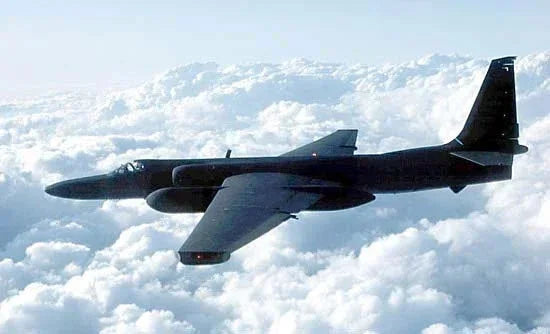The Iconic U-2
In late 1954 the CIA, at the direction of President Eisenhower, was told to develop a high-altitude reconnaissance aircraft due to the growing threat of the Soviet Union.
Lockheed had developed the successful F-104 Starfighter and had been working with a USAF program called Bald Eagle to develop a high-altitude aircraft that could reach 70,000 feet.
The project was suspended, however, until the CIA took charge of the project and contacted Lockheed to continue developing such an aircraft.

The new aircraft was the U-2, the brainchild of legendary aircraft designer Clarence L. "Kelly" Johnson of the Lockheed Corporation.
Lockheed had designed the F-104 Starfighter, and Kelly Johnson felt the proposed CL-282 aircraft could use the same tooling used to build the F-104. The fuselage of the U-2 would be very similar to the fuselage of the F-104.

A drawing showing the basic construction of the Lockheed F-104 Starfighter.
The First Flight
On August 1st, 1955, Lockheed test pilot Anthony M. "Tony" LeVier was conducting taxiing tests of the new U-2 aircraft on Groom Lake, Nevada.
When he reached a speed of 70 knots the U-2 unexpectedly took to flight, startling LeVier who stated he had no expectation that the aircraft would take off!
Because the lake bed had no markings on it there were no visual reference points to let LeVier determine distance or height, making it impossible to safely land the aircraft.
He quickly tried to return the aircraft to the ground but made contact with the lake bed and the aircraft struck the ground in a left bank of approximately 10 degrees.
As soon as the aircraft hit the ground the U-2's tires blew out, and the brakes caught fire because one of the landing gear oleostruts was leaking fluid.
Fortunately, LeVier was uninjured, the aircraft damage was minimal, and 3 days later LeVier was in the cockpit for the first actual test flight of the U-2.
The U-2A
The CIA authorized the construction of the first thirty U-2s were designed and built for the CIA by Lockheed's "Skunk Works" and Clarence L. "Kelly" Johnson.
Because the aircraft was flown at 70,000 feet and higher, the pilot had to wear a David Clark Company-designed MC-3 partial-pressure suit with an International Latex Corporation MA-2 helmet and faceplate.
Each of these suits was custom-made for individual pilots and used a system of capstans and air bladders to apply pressure to the body to compensate for the lower atmospheric pressure at altitude.
On April 4, 1957 U-2A, Article 341, flown by Lockheed test pilot Robert Sieker experienced an engine flame-out at 72,000 feet which also caused the cockpit pressurization to fail.
To absorb radar pulses parts of the aircraft were coated with a plastic material giving the aircraft a "stealth" capability. The problem is that that same material acted as insulation which in turn trapped heat from the engine inside the fuselage. This led to a number of flameouts.
Sieker's partial-pressure suit inflated, but the helmet's faceplate did not properly seal. Upon reaching 65,000 feet he passed out, the U-2 stalled and then entered a flat spin.
Eventually, Sieker regained consciousness and bailed out of the aircraft.
Unfortunately, as he exited the aircraft he was struck by the aircraft's tail and was killed.
The aircraft impacted the ground near Pioche, Nevada, and caught fire. Sieker's body was found approximately 200 feet away from the aircraft wreckage.
U-2 Aircraft Specifications
- Aircraft length: 46 feet, 6 inches;
- Wingspan: 80 feet;
- Empty weight: 10,700 pounds;
- Gross weight: 16,000 pounds;
- Powerplant: Pratt & Whitney J57-P-37A which generated 10,200 pounds of thrust;
- Maximum speed: 528 mph;
- Aircraft ceiling: 85,000 feet;
- Aircraft range: 2,200 miles
The Mission
After the end of the Second World War competition arose between the United States and the Soviet Union over who would be the dominant world power.
March 12, 1947, is recognized as the start of the Cold War which lasted until December 26, 1991.
On January 20, 1953, Dwight D. Eisenhower became the 34th President of the United States after 40 years of military service. His goal was to wage peace, not war.
However, in the second half of 1957, in August, the Soviet Union announced the successful test of an intercontinental ballistic missile capable of carrying atomic weapons.
This was followed in October by the successful launch of "Sputnik", the first orbital artificial earth satellite, and one month later another satellite was launched containing a dog and a television camera!
To many in Congress, fears arose that there now existed a significant advantage that the Soviet Union's missile program was ahead of that of the United States.
Despite the success of launching several satellites by the United States new concerns arose that the Soviet Union was developing a missile arsenal larger than that of the United States.
This was the famous missile gap that received widespread publicity beginning in early 1959.
The Soviet Union was a closed society shrouded in secrecy, and the US could only guess at its true abilities.
This was the impetus for the development of a high-altitude reconnaissance aircraft, and the result was the U-2.
To Be Continued
Next week we will take a deeper look into the U-2 program including its successes and failures.
I hope you enjoyed this trip through some of the history of aviation. If you enjoyed this trip, and are new to this newsletter, sign up to receive your own weekly newsletter here: Subscribe here!
Until next time, keep your eyes safe and focused on what's ahead of you, Hersch!






Leave a comment
This site is protected by hCaptcha and the hCaptcha Privacy Policy and Terms of Service apply.